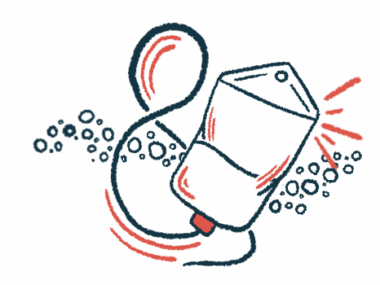Facing the challenges of travel with a chronic illness
Due to aHUS, a columnist's trip to the Greek islands becomes painfully hard
Written by |

This year, I finally did something huge on my bucket list: I went to Greece. Santorini, to be specific.
The white volcanic rock, the sea cliffs overlooking the caldera, the beautiful, iconic blue steeples, and even the flying dress photo shoots — I wanted to see it all. But when I started traveling, I never knew I’d need to factor in antibody therapy and a rare disease.
By 2020, I’d traveled to several major locations in the U.S. — Las Vegas, New Orleans, Florida (multiple times), the Grand Canyon, and more. I’ve been all over the Southeast and to a handful of other states. I also started going on cruises to Mexico, the Bahamas, the Dominican Republic, and Belize.
Then the pandemic hit and my world changed forever. By September 2020, I was dying in the ICU with multiorgan failure from a rare disease called atypical hemolytic uremic syndrome (aHUS). It permanently damaged my kidneys, liver, heart, and uterus. I barely made it out of the experience alive.
My life is now complicated with biweekly antibody therapy for the rest of my life, constant bloodwork, four medications for severe hypertension, chronic kidney disease, rules for what I can eat and drink, rules for over-the-counter medications, constant swelling, and pain from May-Thurner syndrome. I even needed a hysterectomy.
I never imagined I’d have to plan every single trip around lifetime antibody therapy and its side effects. Or that I’d need a hysterectomy before the age of 40. Or that I’d lose muscle mass and stamina from my illness. All of these conditions became real when I went to Greece.
Geographical and logistical obstacles
For starters, hiking through airports was a nightmare. Because I managed to land at one end of the airport and needed to reach the opposite end, I missed my connecting flight from Athens to Santorini.
Next, I stayed in Oia, a quintessential village on the island known for its beautiful lights, deep pink bougainvillea flowers, crisp white buildings, marvelous sea breeze, great shopping, glowing hot tubs, and delicious food. But it required lots of walking up and down stairs and hills, which is my greatest nemesis.
May-Thurner syndrome makes the left side of my body swell, so I have constant pain. Since I’ve been medically fragile for the past three years, I haven’t done much walking, so I wasn’t prepared for the extensive hiking.
Just to leave the studio for food or adventure, I had to descend several steps and then climb about a mile’s worth of larger, uneven steps. The worst part was the walk back from the corner store, which was two streets over. The walk there was downhill — which was great — but the return trip was up a steep incline.
One day, after I’d had a few panicked moments from overdoing it and experiencing a lot of pain, I was nervous about hiking up the hill. But there were no other options, so I began my slow and arduous ascent. I knew I had to pace myself.
But even walking more slowly, I felt a cramp forming in my left calf. The pain moved to the front of my shin. It was so intense it took my breath away. I looked up from my throbbing leg to see that I’d only gone about a quarter of the way.
“Crap!” I thought.
I told myself to push through the pain and get up the hill. But each step hurt more and more. It started to feel like rubber bands were being pulled as far as they could stretch and then snapping each nerve. By that point, I was in tears.
Then the unthinkable happened: I got the worst charley horse I’ve ever had in my life. It seared through the muscle in my left shin like a hot knife cutting through butter. The pain was unrelenting, as if someone were ripping out strips of muscle from my leg.
But I had to make it up that hill and back to my studio. I shifted most of my weight to my right leg and dragged my left one along. By the time I made it to the crest of the hill, I was shaking uncontrollably. Nothing could’ve prepared me for this amount of pain.
The spasms were so severe that they bruised my leg. I had a limp for the remainder of the trip and a few weeks after.
This made me hesitant, and in some cases unable, to participate in other activities. It’s frustrating to have a mind that’s healthy and a body that isn’t.
The main takeaway from all of this is that traveling with a rare disease is all about planning ahead, pacing oneself, and knowing your new limits. I’ll keep that in mind next time I book my ticket.
Note: aHUS News is strictly a news and information website about the disease. It does not provide medical advice, diagnosis, or treatment. This content is not intended to be a substitute for professional medical advice, diagnosis, or treatment. Always seek the advice of your physician or other qualified health provider with any questions you may have regarding a medical condition. Never disregard professional medical advice or delay in seeking it because of something you have read on this website. The opinions expressed in this column are not those of aHUS News or its parent company, Bionews, and are intended to spark discussion about issues pertaining to aHUS.






Leave a comment
Fill in the required fields to post. Your email address will not be published.